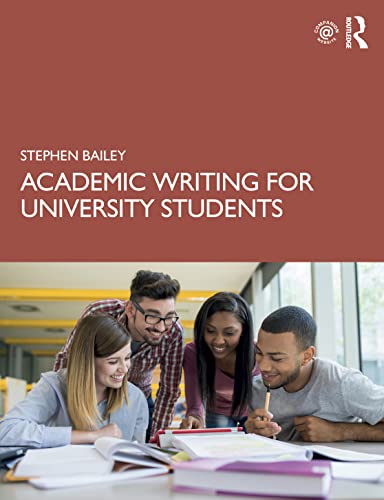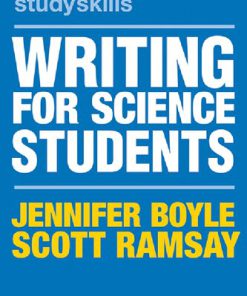Academic Writing for University Students 1st Edition by Stephen Bailey 1000480267 9781000480269
$50.00 Original price was: $50.00.$25.00Current price is: $25.00.
Academic Writing for University Students 1st Edition by Stephen Bailey – Ebook PDF Instant Download/Delivery:1000480267, 9781000480269
Full download Academic Writing for University Students 1st Edition after payment

Product details:
ISBN 10: 1000480267
ISBN 13: 9781000480269
Author: Stephen Bailey
Academic Writing for University Students is designed to help all students succeed in writing essays, reports and other papers for coursework and exams effectively. Academic writing is often the biggest challenge facing college and university students, but this book provides all the tools needed to master the necessary skills. The book is divided into four parts, to help teachers and students easily find the help they need, both in the classroom and for self-study: The Writing Process: From finding suitable sources, through to editing and proofreading Writing Types: Practice with common assignments such as reports and cause-effect essays Writing Tools: Skills such as making comparisons, definitions, punctuation and style Lexis: Academic vocabulary, using synonyms, nouns, adjectives, verbs and adverbs This key handbook breaks down and practises every stage of essay writing. All units are fully cross-referenced, and a complete set of answers to the practice exercises is included. In addition, the companion website hosts comprehensive teaching notes as well as more challenging exercises, revision material and links to other sources. Designed for self-study as well as classroom use, this book uses authentic academic texts from a range of sources and provides models for common writing tasks such as case studies, while progress checks are included for each part to enable students to assess their learning. Academic Writing for University Students is an invaluable guide to all aspects of academic writing in English.
Academic Writing for University Students 1st Table of contents:
Part 1 The Writing Process
1.1 Writing Basics
1 The purposes of academic writing
2 How is academic writing different from other writing genres?
3 Common types of academic writing
4 The format of written assignments
5 Common text features
6 Writing clear sentences
7 Writing in paragraphs
8 Practice
1.2 Understanding Essay Questions and the Planning Process
1 The planning process
2 Analysing essay questions
3 Practice: key words
4 Evaluation criteria
5 Brainstorming
6 Essay length
7 Outlines
8 Practice
1.3 Reading: Finding Suitable Sources
1 Types of text
2 Academic resources
3 Assessing texts
4 Using reading lists
5 Searching library catalogues
6 Using library websites to search journals and bibliographic databases
7 Reading abstracts
8 Practice: varying search terms
9 Assessing text features
10 Reading strategies
11 Practice
1.4 Reading: Developing Critical Approaches
1 Critical thinking
2 Fact and opinion
3 Assessing internet sources critically
4 Domain name suffixes
5 Practice A
6 Practice B
1.5 Finding Key Points and Note-making
1 Why make notes?
2 Finding key points
3 Finding relevant points
4 Practice A
5 Effective note-making
6 Practice B
7 Practice C
1.6 Avoiding Plagiarism
1 Acknowledging sources
2 What is plagiarism?
3 Basic plagiarism
4 Degrees of plagiarism
5 Avoiding plagiarism by summarising and paraphrasing
6 Avoiding plagiarism by developing good study habits
7 Practice A
8 Practice B
9 Research
Progress Check A
1.7 References and Quotations
1 Why give references?
2 Citations and references
3 Reference verbs
4 Practice A
5 Referencing systems
6 Using quotations
7 Practice B
8 Abbreviations in citations
9 Secondary references
10 Internet references
11 Organising the list of references
1.8 Summarising and Paraphrasing
1 What makes a good summary?
2 Stages of summarising
3 Practice A
4 Practice B
5 Practice C
6 Paraphrasing
7 Practice D
8 Techniques for paraphrasing
9 Practice E
10 Practice F
1.9 Contrasting Sources
1 Referring to sources
2 Practice A
3 Contrasting sources
4 Balancing different sources
5 Practice B
1.10 Organising Paragraphs
1 Paragraph structure
2 Practice A
3 Practice B
4 Practice C
5 Introducing paragraphs and linking them together
6 Practice D
7 Practice E
1.11 Introductions and Conclusions
1 Introduction components
2 Introduction structure
3 Opening sentences
4 Conclusions
5 Conclusion structure
6 Practice
1.12 Editing and Proofreading
1 Editing
2 Practice A
3 Practice B
4 Proofreading
5 Practice C
6 Practice D
7 Practice E
8 Practice F
The Panama Canal
9 Summary
Progress Check B
Part 2 Writing Types
2.1 Argument and Discussion
1 Discussion vocabulary
2 Organisation
3 Practice A
4 The language of discussion
5 Argument and counter-argument
6 Practice B
7 Providing evidence
8 Practice C
9 Practice D
2.2 Cause and Effect
1 Causes and effects
2 The language of cause and effect
3 Practice A
4 Practice B
5 Practice C
6 Practice D
2.3 Problems and Solutions
1 Vocabulary
2 Paragraph structure
3 Alternative structure
4 Practice A
5 Practice B
6 Practice C
7 Practice D
2.4 Case Studies
1 Using case studies
2 Planning a case study
3 Background research
4 Model case study
2.5 Literature Reviews
1 What is a literature review?
2 Examples of literature reviews
3 Writing a literature review
4 Model literature review
2.6 Writing Longer Papers
1 Introduction
2 Planning your work
3 Formatting the paper
2.7 Reports
1 Essays and reports
2 Writing reports
3 Scientific reports
4 Practice
2.8 Reflective Writing
1 The purpose of reflective writing
2 Example
3 Structure
4 Style
5 Practice A
6 Practice B
Progress Check C
Part 3 Writing Tools
3.1 Cohesion
1 Reference words
2 Practice A
3 Preventing confusion
4 Practice B
5 Implied language
6 Practice C
7 Practice D
8 Practice E
3.2 Comparison
1 Comparison structures
2 Practice A
3 Using superlatives (e.g. the largest/ smallest)
4 Practice B
5 Forms of comparison
6 Practice C
7 Practice D
8 Practice E
9 Practice F
3.3 Definitions
1 Simple definitions
2 Category words
3 Complex definitions
4 Practice A
5 Practice B
3.4 Examples
1 Using examples
2 Phrases to introduce examples
3 Practice A
4 Practice B
5 Restatement
3.5 Generalisations
1 Using generalisations
2 Structure
3 Practice A
4 Practice B
5 Building on generalisations
6 Practice C
3.6 Numbers and Visual Information
1 The language of numbers
2 Percentages
3 Simplification
4 Further numerical phrases
5 Practice A
6 Visual information: Types of visuals
7 The language of change
8 Describing visuals
9 Labelling visuals
10 Practice B
11 Practice C
3.7 Punctuation
1 Capital letters
2 Full stops (.) [US: period]
3 Commas (,)
4 Apostrophes (’)
5 Semi-colons (;)
6 Colons (:)
7 Quotation marks/ inverted commas (“ ”/ ‘ ’)
8 Others
9 Practice A
10 Practice B
3.8 Style
1 Developing an academic style
2 Guidelines
3 Practice A
4 Avoiding repetition and redundancy
5 Varying sentence length
6 The use of caution
7 Using modifiers
8 Practice B
Progress Check D
Part 4 Lexis
4.1 Approaches to Vocabulary
1 Vocabulary issues
2 Dealing with new vocabulary
3 Language features
4 Confusing pairs
5 Words and phrases from other languages
6 Practice A
7 Abbreviations
8 Common abbreviations
9 Punctuation
10 Duplicate abbreviations
11 Abbreviations only found in writing
12 Practice B
4.2 Academic Vocabulary: Nouns and Adjectives
1 Introduction
2 Nouns
3 Nouns and adjectives
4 Similar adjectives
5 Academic adjectives
6 Practice A
7 Practice B
4.3 Academic Vocabulary: Verbs and Adverbs
1 Understanding main verbs
2 Common academic verbs
3 Using adverbs
4 Practice A
5 Practice B
4.4 Prefixes and Suffixes
1 How prefixes and suffixes work
2 Prefixes
3 Practice A
4 Suffixes
5 Practice B
4.5 Synonyms
1 How synonyms work
2 Common synonyms in academic writing
3 Practice A
4 Practice B
5 Practice C
Progress Check E
Written British and American English – A Short Guide
Glossary
Answers
Index
People also search for Academic Writing for University Students 1st :
why is academic writing important for university students
academic writing skills for university students
an introduction to academic reading and writing for university students
university academic writing for international students a usage based approach
Tags:
Stephen Bailey,Academic Writing,University Students
You may also like…
Business & Economics - Others
Academic Writing for International Students of Business and Economics 3rd Edition Stephen Bailey
Education Studies & Teaching - School Education & Teaching
Education Studies & Teaching
Uncategorized
Uncategorized
Education Studies & Teaching - Education - General & Miscellaneous
Academic Writing for International Students of Science 2nd Edition Jane Bottomley
Uncategorized
Education & Teaching











